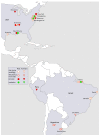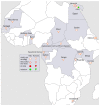Wild Rats, Laboratory Rats, Pet Rats: Global Seoul Hantavirus Disease Revisited
- PMID: 31319534
- PMCID: PMC6669632
- DOI: 10.3390/v11070652
Wild Rats, Laboratory Rats, Pet Rats: Global Seoul Hantavirus Disease Revisited
Abstract
Recent reports from Europe and the USA described Seoul orthohantavirus infection in pet rats and their breeders/owners, suggesting the potential emergence of a "new" public health problem. Wild and laboratory rat-induced Seoul infections have, however, been described since the early eighties, due to the omnipresence of the rodent reservoir, the brown rat Rattus norvegicus. Recent studies showed no fundamental differences between the pathogenicity and phylogeny of pet rat-induced Seoul orthohantaviruses and their formerly described wild or laboratory rat counterparts. The paucity of diagnosed Seoul virus-induced disease in the West is in striking contrast to the thousands of cases recorded since the 1980s in the Far East, particularly in China. This review of four continents (Asia, Europe, America, and Africa) puts this "emerging infection" into a historical perspective, concluding there is an urgent need for greater medical awareness of Seoul virus-induced human pathology in many parts of the world Given the mostly milder and atypical clinical presentation, sometimes even with preserved normal kidney function, the importance of simple but repeated urine examination is stressed, since initial but transient proteinuria and microhematuria are rarely lacking.
Keywords: Seoul virus (SEOV); acute kidney injury (AKI); brown rat; hantavirus; hantavirus cardio-pulmonary syndrome (HCPS); hantavirus disease; hemorrhagic fever with renal syndrome (HFRS); laboratory rat; pet rat; wild rat.
Conflict of interest statement
The authors declare no Conflicts of Interest.
Figures




References
-
- Fill M.A., Mullins H., May A.S., Henderson H., Brown S.M., Chiang C.F., Patel N.R., Klena J.D., de St Maurice A., Knust B., et al. Notes from the Field: Multiple Cases of Seoul Virus Infection in a Household with Infected Pet Rats—Tennessee, December 2016-April 2017. Mmwr. Morb. Mortal. Weekly Rep. 2017;66:1081–1082. doi: 10.15585/mmwr.mm6640a4. - DOI - PMC - PubMed
-
- Jameson L.J., Taori S.K., Atkinson B., Levick P., Featherstone C.A., van der Burgt G., McCarthy N., Hart J., Osborne J.C., Walsh A.L., et al. Pet rats as a source of hantavirus in England and Wales, 2013. Euro Surveill. 2013;18:20415. - PubMed
Publication types
MeSH terms
Grants and funding
LinkOut - more resources
Full Text Sources

